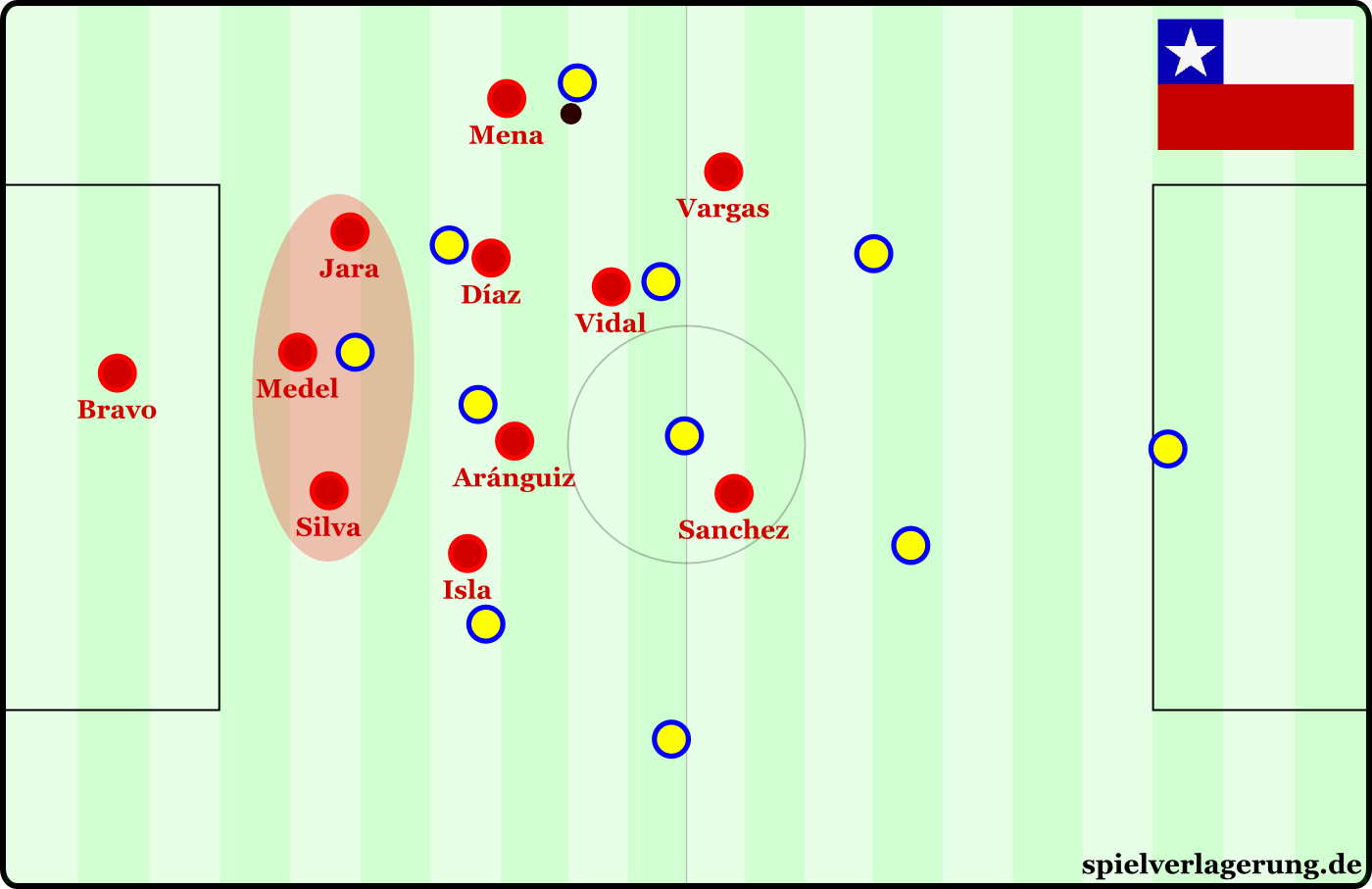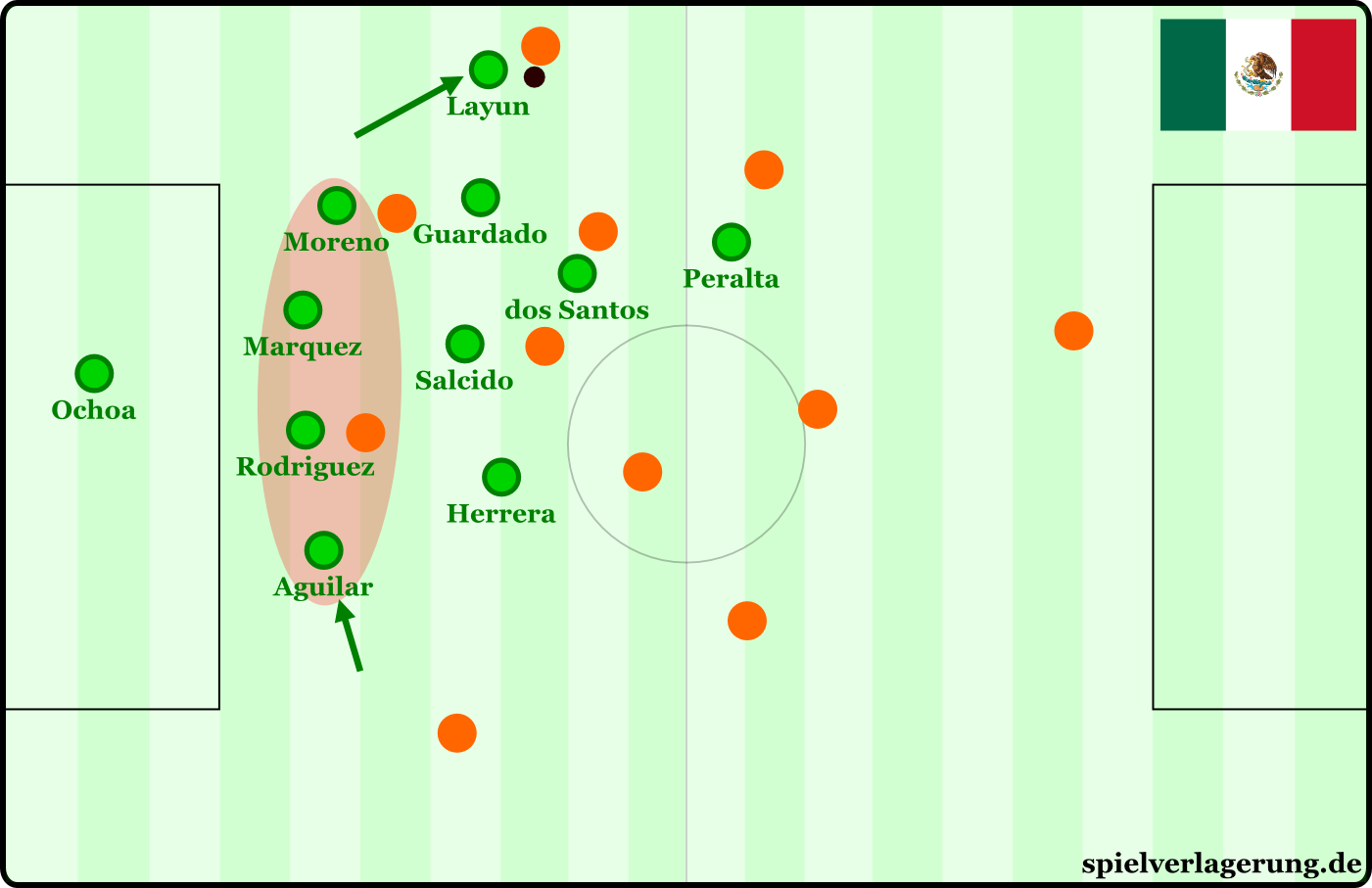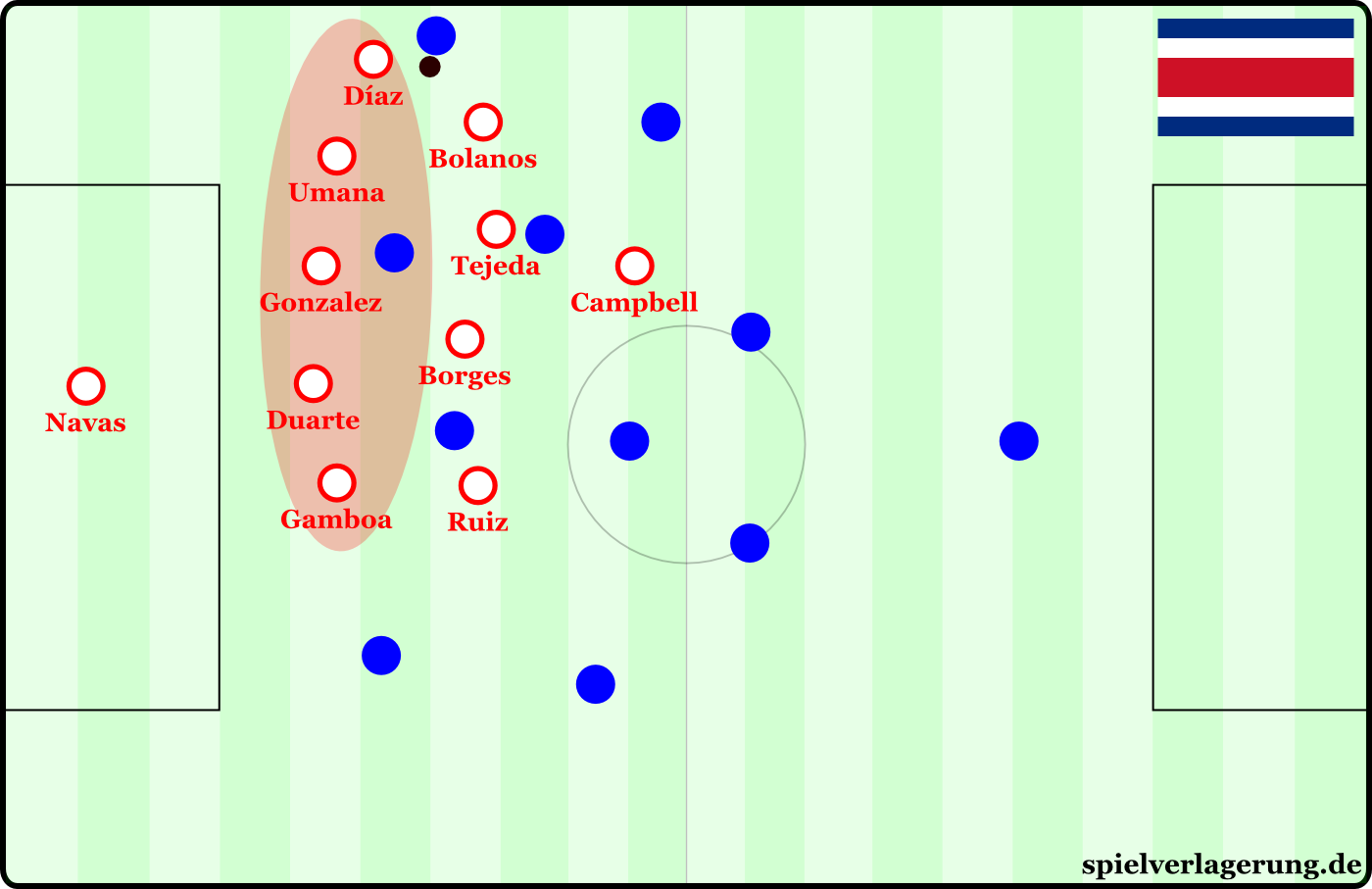Three at the back, chains and variations of it
In this World Cup we have witnessed a big tactical trend emerge: the abandonment of the back four as dogma. While only one team at the 2010 World Cup played without a back four, several teams used a different style of defense this time around.
Chile played convincingly with a back three. Mexico, Argentina, and to some extent the Netherlands, used a pendulating back four, while Uruguay and Costa Rica deployed five at the back. This article originally appeared in German on abseits.at to clarify the differences between these three implementations, all of which share the same basic alignment and layout, and what strategic strengths, weaknesses, and counterattacking options are available in each.
The back three
The most frequently mentioned example in the mainstream media – and, in reality, the most rarely used – is the back three. Now, we must mention that even a back three can often become four or five players in a line. What matters is how the players move in relation to each other. In a three-man line, the wing-backs can often situationally drop back into line with the three central defenders, but in the movement itself they do not do so on a consistent basis.
Thus, the wing-backs, by moving man-oriented to an opponent (and thus not moving ball-oriented like the three players in the middle), can also be connected to the midfield and move with it or also take up a flexible position in open space. Modern examples of a clear back three are exceedingly rare: recently the Chileans, Barcelona under Josep Guardiola in 2012, the Catalans under Guardiola’s predecessor Johan Cruijff in the early ‘90s or Louis van Gaal’s Ajax Amsterdam are the most prominent teams to use this approach.
If the wings aren’t occupied consistently enough or with enough presence, it is difficult to provide width in the final third on defense, and, all in all, it is a complex style that is difficult to implement. Many other teams set about using a classic back four or even five. However, one compromise is the “pendulating” back four.
The pendulating back four
When using a pendulating back four, elements of the back three, four and five are mixed. Basically, the five defenders stand in a line (or a crescent shape), but the wide players are ready to move out of the chain when the opponent is on one side or the other.
The near-side wing-back then no longer shifts with the other players, but pushes out from the five-chain and presses higher in the midfield. This is most often accomplished through man orientations on the wings. The remaining defensive players don’t follow him out, but stay on a line and move as a ball-oriented back four. This means that the far-side wing-back moves into the back four and is no longer positioned as high as his counterpart.
The result resembles Newton’s cradle; the three central players remain the same, while a wing-back peels off the chain depending on triggers from the opponent’s attack side, and the other falls in line. So you have four players in a row that move accordingly, like a chain connected to the ball, with only the outermost players alternating.
In contrast to the back three there is less pressure and presence in midfield, but the problems of a three-chain are very well concealed. By the near-side player moving out and pressing at midfield level, he obtains access and generates aggressiveness, while the other far-side wing-back offers support, securing the shifting of the three central defenders and improving the width of the formation. If the opposition switches flanks he can then protect the back-line well and move out unimpeded as the previously advanced wing-back simply drops back into the back line. When there are crosses they also create a greater central presence in the penalty area, allowing them to be handled better.
However, gaps can arise on the sides and in the half-spaces when the wing-back pushes up to attack. This presence in the half-spaces is one of the great advantages of the five chain.
The five-chain
In the five-chain the five players all move together. If the ball goes to the wing, then the chain moves evenly and equally to that side. The five players are only a very short horizontal distance from one another, creating greater compactness and making it harder for the opposition to play through. Bombing runs down the flank by the near-side wing-back are therefore impossible, in principle, but there the tradeoff is a better organization and structure in the defensive game. This is particularly evident when the central players push up to press, as they are always very well secured and hardly open any gaps; with a pendulating back-four and good passes in the open spaces between the lines, this security is lacking.
However, there are also certain disadvantages compared to the pendulating back four. The formation’s width is a little weaker, but this is usually related to the higher number of players at the back. What’s more problematic are the unsuitable attack channels and the players’ positioning when the opponent is circulating the ball well in the half-spaces and playing forward diagonally. This leads to a stronger element of control at the back of the opposition’s ball circulation, which can naturally be both positive and negative; often it is a more stable, but altogether passive style.
A line without a chain and variable handling
As a last resort, there are defenses with three or five players, where there is no clear chain mechanism. The Dutch had many defenders organized on a line and in a band, but always man-oriented when they pushed up to press; whether in the center or on the wings. There is then no clear chain, but this is intuitively solved in small groups. For example, a central defender can then move up to press while the surrounding players tuck in and cover him (a generally consistent group tactical means), while they can in certain positions or in certain situations, that he will not be covered by the indenting or equal pushing up of more than one player. Alternatively, it would also be possible to variably switch between a triple-chain, five-chain, and a pendulating back four depending on the opponent and the situation during the game. Swansea City under Michael Laudrup, for example, did this often with a back four as a basic orientation.
The fundamental strategic advantages
Whether it’s a three-chain, a pendulating four, or a five-chain: in all three systems there are certain aspects which promise a strategic advantage and are common features of these three implementation options, such as playing with three central defenders. This directly follows another theoretical consistency, namely to play with only one wing player per side.
This is often a disadvantage in amateur football and amateur sports, but via the ball-oriented shifting and the athleticism in modern football the disadvantage of the simple wing occupation can be neutralized, while the strategically important zones in the horizontal – the half-spaces and the center – are occupied. This increased presence and the associated increase in access generate a higher defensive stability. With five- and pendulating four-chains this is further enhanced by the increased width of the formation in the defensive third, while the increased presence and compactness of the three-chain is in the midfield.
This increased coverage or compactness and the generally stronger central concentration also ensure that the respective teams can play much more intensely and dynamically. A team can then impose their rhythm on the opponent more easily or at least keep them out of the strategically important areas. Besides developing access to the opponents this effect also increases access to more areas of the field due to the simplified reachability of different zones.
From the half-spaces they can very simply go out wide or back to the center, because both spaces are directly accessible. Various overloads are thus possible and lead to a more flexible attacking than defensive style; at this World Cup there were 5-4-1, 5-3-2, 5-2-3, 3-4-1-2 and 5-3-1-1-formations. In addition to the game against the ball, there are also multiple potential offensive benefits to having three central defenders.
On the one hand, the midfield always has three passing options at the back, in addition to the goalkeeper. The formations are also better suited and less prone to the opponent pressing back passes, as opposed to playing with only two central defenders. Furthermore, the three defenders can flexibly move forward; the half-back can, for example, be covered well in the space around the opposing strikers when he moves forward, e.g. when an opponent presses in a 4-4-2), while the central defender can orient forward. This could be seen in the DFB Cup final last season by Bayern Munich where Martinez stood somewhat higher during very deep ball circulation and Neuer acted almost on a level with the wide half-back. In addition, further synergies can be added along with the goalkeeper as well as the midfield, such as dropping the six into the gaps between the center back and half-back or the half-back and wing-back, to create more Dynamik.
One can even observe a certain positive momentum in transition when playing with three central defenders (and singly occupied wings). After losing the ball a team can increase their presence in the center and half-spaces to better control the opposition’s counterattack or effectively gegenpress, as with three players in the back line they are always well protected and can release cleanly after recovering the ball.
In offensive transitions the two wing-backs can push forward because they are very well covered by the central players and always have a nearby passing option for easy passes back. If the center- and half-backs have the technique they can then use their nice view of the field to get the ball forward.
But, among the many benefits, there are also some disadvantages compared to the classic back four or playing with two central defenders.
The disadvantages
There are also reasons that speak for a classic back four and against a game with a three-chain, five-chain, or pendulating four. There is often a lower presence in the higher zones, as both with and without the ball there are five defenders and with three centrally bound defenders there are only five remaining players who can occupy the center and the half-spaces in the midfield band. If one uses all five or at least four players to fill these extremely important areas, however, they will often lack presence in the final third; both centrally and in providing width on the wings.
Depending on the orientation of the midline, such as with a 5-4-1, one can indeed compensate for this, but that is again at the expense of ball circulation to the center forward and penetrating the penalty box. Due to these same positioning problems there is a half-automatic defensive focus against the ball, the need to work deliberately higher and with a very active alignment and suitable movement.
However, the two biggest problems are of a different nature. When playing with a five-chain, or just three players in defense a team is sometimes prone to being outplayed on the sides. Even simple wing teams can turn quickly turn gained space into an unpleasant dominance, which then usually negatively influences one’s own offensive transition or its effectiveness. With a very compact defense and an intense 4-4-2 the opponent can, for example, find it relatively easy to have good chances for success, if the offensive movements of the structure are suitable.
This leads to an increased complexity of the game by the offside trap. Although Costa Rica’s five-chain recorded a record number of offsides against their opponents at this World Cup, it is usually more difficult to coordinate the appropriate movements with a five-chain. If the collective doesn’t move up at the right moment, or simply does not hold the line correctly somewhere, they risk passes getting in behind the defense.
Conclusion: The future and the antidote
Overall, the five-chain or back three, in their variations, represent a very interesting tactical orientation which has many interesting strengths. In the long term it may mean that we see even more three-chains, five-chains, and pendulating fours, which are combined with the classic back fours and their variations. A move away from the back four to a comprehensive use of a three- or five-chain is unlikely; in Central Europe it is likely to be used more as a one-off.
Nevertheless, in the long run teams might take up this tactical aspect, at least to have it in their repertoire for situational use, as is already the case in Italy, but also for Guardiola’s Bayern and Rodgers’s Liverpool. It will also be interesting to the see the response to it; wing overloads, constructive ball circulation around the half-spaces, and possession football with intelligent use of suitable attack channels are all interesting possibilities.
Bayern Munich adapted Juventus’s 3-5-2/5-3-2, using a pendulating back four, with a shift of the pressing pattern and a 4-3-3/4-2-4 formation as well as the above mentioned strategical aspects. If this continues in the coming years, then the football world can look forward to more variety and flexibility; playing-wise, this is not a problem, as the World Cup has shown.



2 Kommentare Alle anzeigen
Izi July 26, 2014 um 6:35 am
Great article! 🙂 RM has proven to be eloquent in both English and German, thus being a suitable manager in the Bundesliga as well as the Premier League! When are you signing your first professional contract? 😉
I’m really looking forward to both seasons, hoping to see more variations of the classical back four. Hasn’t Dortmund shown first approaches as well?
RM July 26, 2014 um 9:24 pm
Haha, probably never but thanks. Though the articles are translated by rafamufc.
Yes, they did; you could call it pendulating three at the back, haha. Ball near full back advances and attacks, the other three play in a line. Robin Dutt even said that BVB and Bayern play a “Zweierkette”, where the two CB’s play as a chain in one line while the fullbacks are more like advanced defenders in midfield.